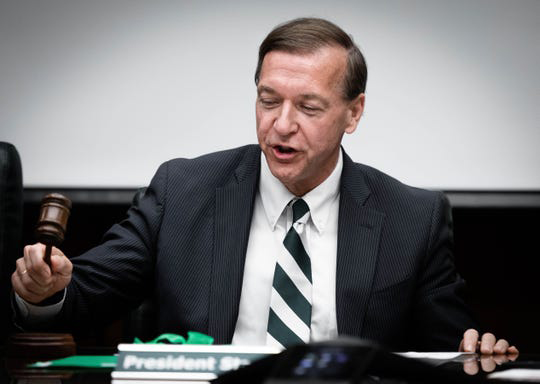MSU files motion to dismiss Nassar survivor lawsuits

New Michigan State University President Samuel Stanley closes out the first MSU Board of Trustees meeting, Friday, Sept. 6, 2019, in the Hannah Administration building. COURTESY / Matthew Dae Smith/Lansing State Journal
Sep 9, 2019
On Monday, Aug. 26, Michigan State University filed a more than 1,000-page motion to dismiss over 100 lawsuits filed by Larry Nassar survivors. These lawsuits came after the $500 million settlement that took place in May 2018, which covered the first group of survivors who came forward, now known as the “first wave” survivors. However, more lawsuits were filed during those negotiations, and more than 170 lawsuits had been filed by “second wave” survivors by Sept. 2018.
While the university is facing backlash from their motion to dismiss the lawsuits, MSU Vice President and Spokesperson Emily Guerrant said it does not deter the university’s intent on settling with the second wave of plaintiffs.
“It is a legal filing,” Guerrant said. “It was ordered upon us by the court that if in the future we ever wanted to use any defenses, if we ever wanted to fight any of the claims, we had to file the angles, or the types of information we would use to fight them, at this time. So that was a court-ordered deadline that we had to answer if we wanted to use that information in the future.”
Guerrant added that around 90 of the 170 second wave survivors have already been settled, and the majority of the remainder are in active negotiations. However, even with these apparent efforts, complaints have been sounded from survivors nationwide. The Michigan Association for Justice (MAJ) believes that MSU’s actions are further wounding survivors.
“Michigan State did not have to file these motions – they were not required to file these motions,” said MAJ President-Elect Donna Mackenzie. “They could have made a conscientious decision to respect the survivors, to respect the healing process and not file these motions, but they didn’t. Either they didn’t think about the impact it would have on the survivors or they didn’t care.”
Part of the unease surrounding the motion for dismissal is the inconsistency in treatment of the wave one and wave two survivors by MSU. The university settled with the wave one survivors, but are attempting to dismiss the cases by wave two survivors. Mackenzie said that both groups deserve to be treated equally by MSU.
“It makes no sense that they’re doing this or that they are trying to treat these people differently,” Mackenzie said. “There is no difference between the first wave and the second wave. If anything, the second wave has a number – I think it’s a majority – of survivors who are still minors… It’s inconsistent with the message that Michigan State is trying to assert publicly, which is that they want to support, they want to do right, they want to make it right.”
The next step in the process for the filed dismissals is a court hearing. Mackenzie said that responses from the survivors will be due at the end of October. The court will then hear oral arguments on the motions and make a decision on whether to grant MSU’s motions. Current MAJ President Robert J. MacDonald fears that if the motions are granted it will further traumatize survivors.
These dismissal motions were filed just days before the U.S. Department of Education released a report and issued a record $4.5 million fine to MSU for its mishandling of the Nassar sexual abuse allegations and their failure to comply with the Clery Act – an act that requires universities to disclose campus security information and crime statistics.
To improve in their efforts towards the Clery Act, Guerrant said MSU’s new president, Samuel Stanley, has put together an oversight committee focused on making sure MSU complies with the Clery Act requirements. Guerrant also said that MSU has been working hard to provide new resources to survivors.
“Up until a couple years ago, we did not have a strong effort on the prevention side of sexual assault – we had one person who was supposed to do education and training for our campus, which is 70,000 people,” Guerrant said. “So we’ve added significant resources financially and more people to have a more robust prevention effort. We’ve also added more resources to the response side of assault, relationship violence and sexual misconduct.”
The Nassar case and sexual misconduct issues at MSU have also sparked change in universities state-wide, including Grand Valley State University. GVSU Victim Advocate Krystal Diel said that one outcome of the issues at MSU was a new position in the Center for Women and Gender Equity.
“The Board of Trustees created the Violence Prevention Education Coordinator position, so that position has been around since January 2019,” Diel said. “I would say that while our work has been growing and the work our center has been doing is constantly expanding, I think a lot of what happened at MSU gave Grand Valley some of the opportunity to revisit that and say, ‘Okay, let’s add on another position. Let’s have someone dedicated to violence prevention work.’”
GVSU has resources in place to prevent what happened at MSU from happening in the Laker community. Some of these resources include GVPD, the Center for Women and Gender Equity, Title IX and the University Counseling Center.
“When we say ‘It’s on us,’ I think it’s on all of us,” Diel said. “It’s on students to take care of each other and it’s also on faculty and staff and the university to make sure their students are protected and have a supportive environment if any harm does come to them.”






















